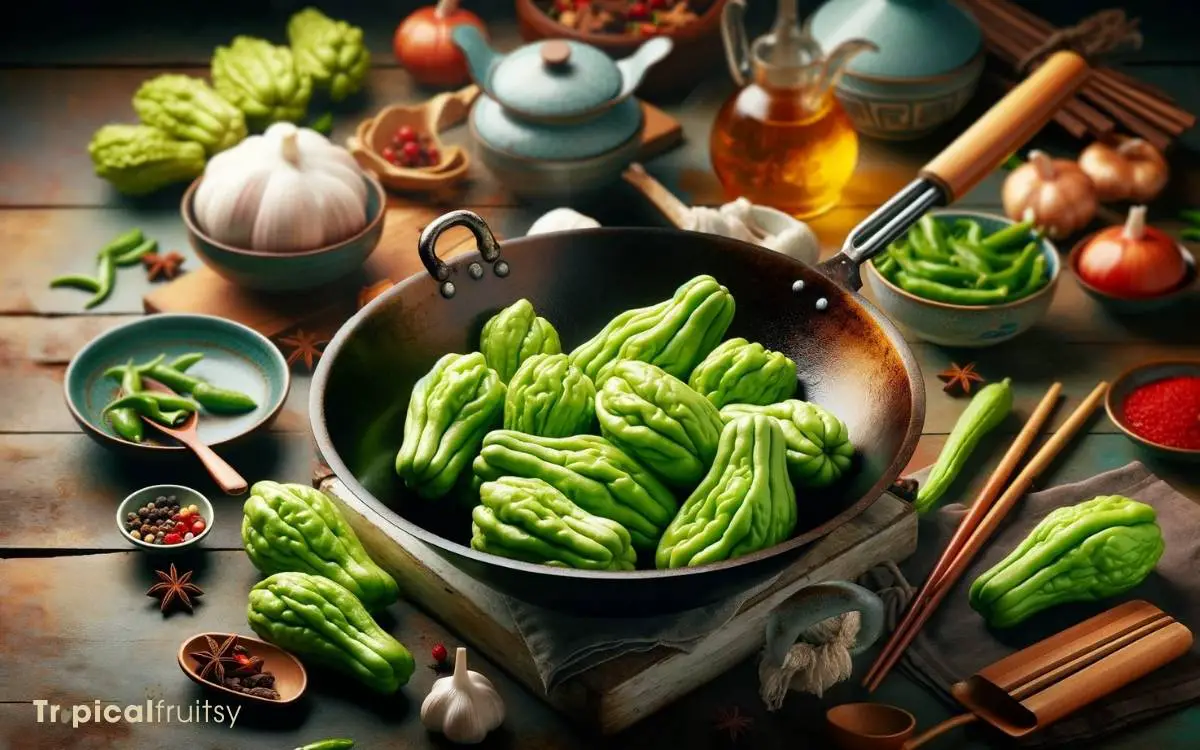How to Cook Chayote Chinese Style? 9 Easy Steps!
To cook Chayote Chinese style, stir-fry sliced chayote with garlic, ginger, and scallions. Add soy sauce and a pinch of sugar for flavor, and cook until tender.
Chayote, also known as choko or vegetable pear, is a light green, squash-like vegetable that is often used in Chinese cuisine.
Cooking it Chinese style involves a swift stir-fry that keeps the chayote crisp-tender while infusing it with classic Chinese flavors.
Here’s a simple guide:
A short example of using chayote in Chinese cooking could be in a dish like “Stir-fried Chayote with Black Bean Sauce,” where the vegetable is cooked with fermented black beans and chili peppers for a bold flavor profile.
Experience the fresh crunch of chayote in a classic Chinese stir-fry, where its subtle sweetness is perfectly enhanced by savory garlic and rich soy sauce.

Key Takeaway
Step 1: Selecting Fresh Chayote
Before we delve into the cooking process, let’s ensure we’re starting with the best produce by selecting fresh chayote.
We’re looking for firm, unblemished chayotes with a bright green hue. They should feel heavy for their size, a sign of juiciness and freshness.
Avoid any with soft spots or signs of withering. When we hold them, they ought to have a subtle, crisp texture, indicating they’ve been harvested at the right time.
Gently press the skin; it should yield slightly but not be too soft. A good chayote will have a subtle sweet scent, noticeable but never overwhelming.
Now that we’ve got the perfect chayotes, we’re ready to move on to preparing the ingredients, ensuring our dish is as authentic and flavorful as possible.
Step 2: Preparing the Ingredients
We’ll begin by washing the chayote thoroughly under cold running water to remove any dirt or residue.
After patting them dry, we’ll carefully peel the skin, which can be tough and bumpy. It’s essential to use a sturdy peeler or a sharp knife for this task, taking care not to remove too much of the flesh.
Next, we’ll slice the chayote in half and scoop out the pit, similar to preparing an avocado. The flesh of chayote is crisp and tender, so we’ll cut it into uniform pieces, ensuring they cook evenly.
Whether we opt for thin slices or bite-sized cubes, it’s crucial to maintain consistent shapes for our traditional Chinese dish to come together harmoniously.
Step 3: Essential Chinese Spices
Why shouldn’t we dive into the fragrant world of essential Chinese spices that’ll elevate our chayote dish with authentic flavors?
These spices are the soul of Chinese cuisine, and we’re about to explore three key players that are vital for that genuine taste:
- Sichuan Peppercorns: These aren’t your typical peppercorns. They offer a unique aroma and a tingling sensation that’s characteristic of Sichuan dishes.
- Star Anise: Shaped like an eight-pointed star, this spice imparts a deep, licorice-like sweetness, essential to balance the flavors in our dish.
- Five-Spice Powder: A blend that typically contains star anise, cloves, Chinese cinnamon, Sichuan peppercorns, and fennel seeds, creating a symphony of flavors that sings harmony into every bite.
Incorporating these spices, we’ll infuse our chayote with layers of traditional Chinese taste.
Step 4: Marinating Techniques
Harnessing the aromatic power of our selected spices, we’re now set to master the marinating techniques that will ensure our chayote absorbs every nuance of flavor.
We delicately blend our traditional spices, considering the balance of the five flavors: sweet, sour, bitter, salty, and umami.
Our chayote slices bathe in this rich concoction, allowing the subtle essence of star anise, the warmth of Sichuan peppercorns, and the zest of ginger to permeate their fleshy core.
It’s crucial we give time its due respect, letting the chayote marinate, covered, in a cool environment.
This patience rewards us with vegetables that not only carry the depth of our heritage in every bite but also bring forth a harmony of tastes that truly respect the Chinese culinary philosophy.
Step 5: Stir-Fry Basics
After marinating the chayote, we’ll heat the wok to a high temperature before adding oil to start the stir-frying process. It’s crucial to get the wok smoking hot to ensure the chayote cooks quickly and retains its crisp texture.
Once the oil shimmers, signaling it’s ready, we swiftly add the chayote, keeping it in constant motion.
Here are the essential steps we follow:
- Maintain High Heat: This seals in the chayote’s flavor and texture.
- Stir Constantly: Prevents sticking and ensures even cooking.
- Brief Cooking Time: Chayote should stay crunchy, not mushy.
Step 6: Sauce and Seasoning Mix
We’ll now turn our attention to the heart of Chinese cooking: the sauce and seasoning mix. Achieving the quintessential balance of flavors is crucial, and it begins with sourcing traditional ingredients like soy sauce, oyster sauce, and sesame oil.
Let’s explore how these components combine to elevate the simple chayote to a dish brimming with authentic Chinese flavor.
Flavor Balance Essentials
We can enhance the mild taste of chayote by creating a balanced mix of traditional Chinese sauces and seasonings. Achieving the perfect harmony in flavor is crucial for this dish to resonate with the authentic Chinese palate.
Here’s how we do it:
- Soy Sauce: A splash of soy sauce provides a savory umami base, indispensable for grounding the dish.
- Oyster Sauce: For a touch of sweetness and depth, we blend in oyster sauce, which pairs splendidly with the chayote’s subtle flavor.
- Sesame Oil: A few drops of sesame oil are essential for that nutty finishing touch, sealing the deal on this symphony of tastes.
Each component plays a vital role, and we’re careful to measure just enough to complement, not overwhelm, the chayote’s natural taste.
Authentic Chinese Ingredients
In crafting our sauce and seasoning mix, we use several authentic Chinese ingredients to ensure each bite is infused with traditional flavors.
These staples are the essence of our culinary heritage, carefully balanced to bring out the unique taste of chayote in a way that honors our gastronomic history.
| Ingredient | Description | Role in Flavor |
|---|---|---|
| Soy Sauce | Aged, fermented soybeans | Salty depth |
| Oyster Sauce | A rich, syrupy mix | Savory umami |
| Sesame Oil | Pressed from roasted seeds | Nutty aroma |
We meticulously measure and blend these components, considering the yin and yang of taste that is quintessential to Chinese cooking.
The soy sauce provides a foundational saltiness, the oyster sauce adds a layer of complexity, and the sesame oil introduces a toasty warmth. With these elements combined, we’re ready to move on to the next step: cooking with aromatics.
Step 7: Cooking With Aromatics
Amidst the sizzle of the hot wok, we’re adding finely chopped garlic, ginger, and green onions to form the aromatic base for our chayote dish.
These ingredients are essential in creating a fragrance that tantalizes the senses and infuses the chayote with rich, savory notes. The key is to stir-fry them just until they’re fragrant, ensuring they don’t burn.
Here are the steps to perfecting the aromatics:
- Heat the wok until it’s just smoking, then add oil to coat the bottom.
- Toss in the garlic and ginger, stirring quickly to release their pungent aromas.
- Add the green onions next, and stir-fry briefly before introducing the chayote to the mix.
We understand the importance of this step in achieving that authentic Chinese flavor profile.
Step 8: Final Touches
As we near the completion of our chayote dish, it’s crucial to master the art of garnishing, which not only adds a burst of color but also enhances the flavors.
We’ll ensure the seasoning is perfectly balanced, paying homage to the delicate interplay of tastes that Chinese cuisine is renowned for.
Garnishing Techniques
We’ll enhance our Chinese-style chayote dish with a few artful garnishes that add both flavor and visual appeal. In the tradition of Chinese garnishing, we pay as much attention to the final touches as to the cooking itself.
Here’s how we’ll do it:
- Fresh Cilantro Leaves: We’ll sprinkle finely chopped cilantro over the chayote, offering a burst of freshness and a vibrant green color that contrasts beautifully with the pale chayote flesh.
- Toasted Sesame Seeds: A generous scattering of toasted sesame seeds will give a subtle nuttiness and a delightful crunch, complementing the tender texture of the chayote.
- Julienne Ginger Strips: Finally, we’ll add thin strips of ginger for a sharp, piquant kick that punctuates the dish’s flavor profile, staying true to our Chinese culinary roots.
Adjusting Seasoning Balance
After garnishing our chayote, let’s fine-tune the flavors, ensuring that the sweet, sour, salty, and bitter elements are perfectly balanced to suit our tastes.
In the art of Chinese cooking, achieving harmony in our dish is paramount. We’ll taste and adjust, adding a pinch of this or a splash of that, guided by centuries-old culinary wisdom.
Here’s a simple table to help us consider our seasoning:
| Flavor Element | If Too Strong | To Balance |
|---|---|---|
| Sweet | Add vinegar | Use soy sauce |
| Sour | Sprinkle sugar | Incorporate broth |
| Salty | Mix in water | Add sliced chayote |
We want each bite to sing with complexity and depth, resonating with the traditional flavors that make Chinese cuisine so revered. Let’s trust our palates and create a dish that’s both authentic and reflective of our personal taste.
Plating Presentation Tips
With our chayote’s flavor meticulously balanced, let’s turn our attention to the art of plating, where visual appeal is as crucial as taste.
The harmony of the dish extends to the presentation, where each element is thoughtfully arranged to create a feast for the eyes.
Here are three key tips to enhance the visual allure of our dish:
- Contrast and Color: Place the vibrant green chayote against a contrasting plate to make the color pop.
- Height and Structure: Layer the chayote slices or cubes to give the dish dimension and an architectural aesthetic.
- Garnish with Intent: A sprig of cilantro or a sprinkle of toasted sesame seeds adds a traditional touch without overpowering the simplicity of the dish.
Step 9: Serving Suggestions
Once we’ve mastered the art of cooking chayote Chinese style, let’s explore the various dishes it can complement. The crisp texture and mild flavor of chayote make it a versatile addition to a range of traditional Chinese meals.
We can serve it alongside robust dishes, as a refreshing counterbalance, or incorporate it into lighter meals for an added crunch.
Here’s a table with serving suggestions that embody the harmony of Chinese cuisine:
| Dish Type | Serving Suggestion |
|---|---|
| Meat | With Kung Pao Chicken |
| Seafood | Tossed in a Shrimp Stir-fry |
| Vegetarian | As a side to Ma Po Tofu |
| Noodles | Mixed into Lo Mein |
We ensure every meal is a symphony of flavors that speaks to the soul of authentic Chinese cooking. Enjoy our chayote in these dishes for a traditional and satisfying dining experience.
How to Cook Chayote with Egg
Cooking chayote with egg is a simple and nutritious dish that can be enjoyed at any time of the day.
Here’s a basic recipe to get you started:
Ingredients:
- 1 chayote, peeled and thinly sliced or julienned
- 2-3 eggs
- 2 cloves of garlic, minced
- 1 small onion, thinly sliced
- Salt and pepper, to taste
- 2 tablespoons of oil (vegetable or olive)
- Optional: soy sauce, oyster sauce, or your choice of seasoning for extra flavor
- Optional: green onions or cilantro for garnish
Instructions:
- Prepare the Chayote: Peel the chayote and cut it into thin slices or julienne strips. Some prefer to remove the seed, but it’s edible and can be included if desired.
- Sauté the Aromatics: Heat the oil in a pan over medium heat. Add the minced garlic and sliced onion. Sauté until the onion becomes translucent and the garlic is fragrant but not burnt.
- Cook the Chayote: Add the sliced chayote to the pan. Stir well to mix it with the garlic and onion. Cover the pan and let it cook for about 5 to 7 minutes, or until the chayote is tender but still slightly crisp. If you like a softer texture, cook it a bit longer.
- Season: Season the chayote with salt and pepper to taste. If you’re using additional sauces like soy sauce or oyster sauce, add them at this stage. Mix well to ensure the chayote is evenly seasoned.
- Add the Eggs: Crack the eggs directly into the pan over the chayote. Let them sit for a moment before gently stirring to scramble them with the chayote. Cook until the eggs are fully set.
- Garnish and Serve: If you’re using any garnish like chopped green onions or cilantro, sprinkle them on top. Serve the dish hot, either on its own or with a side of rice for a more filling meal.
This dish combines the mild, slightly sweet flavor of chayote with the richness of eggs, creating a healthy and satisfying meal. Feel free to adjust the seasoning and add additional ingredients based on your preferences.
Enjoy your cooking!
Conclusion
We’ve just embarked on an epic culinary journey, transforming humble chayote into a masterpiece that could rival the Great Wall in grandeur!
Our stir-fry is a symphony of flavors, with spices that sing and sauces that dance. Each bite is a trip down the Silk Road, bursting with history and tradition. Trust us, your taste buds will be doing somersaults of joy.
Now, serve this legendary dish and watch it vanish faster than a dragon’s puff of smoke!






